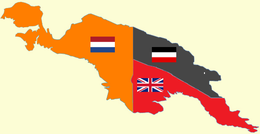Kaiser-Wilhelmsland

Kaiser-Wilhelmsland 1884–1919
|
|
| Geography | |
|---|---|
| Location | northeastern quarter of the Island of New Guinea, north of Australian continent |
| Coordinates | 6°50′S 146°40′E / 6.833°S 146.667°ECoordinates: 6°50′S 146°40′E / 6.833°S 146.667°E |
| Area | 181,650 km2 (70,140 sq mi) |
| Highest elevation | 4,121 m (13,520 ft) |
| Highest point | Saruwaged Massif 6°18′39″S 147°05′27″E / 6.31083°S 147.09083°E |
| Administration | |
| Demographics | |
| Population | 110,000 (1902) |
Kaiser-Wilhelmsland was part of German New Guinea (German: Deutsch-Neuguinea), the South Pacific protectorate of the German Empire. Named in honour of Wilhelm II, who was the German Emperor and King of Prussia, it included the north-eastern part of present-day Papua New Guinea. From 1884 until 1918, the territory was a protectorate of the German Empire. Kaiser-Wilhelmsland, New Pomerania, the Bismarck Archipelago, the northern Solomon Islands, the Caroline Islands, Palau, Nauru, the Mariana Islands, and the Marshall Islands comprised German New Guinea.
Most of the German settlers to Kaiser-Wilhelmsland were plantation owners, miners, and government functionaries, and the number of European settlers, including non-Germans, was never very high. In 1885, Lutheran and Catholic congregations sent clergy to establish missions, who experienced moderate, but very slow, success with the indigenous peoples. Missionaries and plantation owners alike were limited by tropical diseases, travel, and communication barriers.
The protectorate was never fully explored by the Germans, although in 1914, the Imperial German Government mounted an expedition to explore and map the interior. Lutheran missionaries were frequently the first Europeans to explore the interior and examine the different fauna and flora.
At the outbreak of war in 1914, the German protectorate was quickly overrun by British-Australian troops. In 1918, as part of the settlements ending World War I, Kaiser-Wilhelmsland was administered by the Commonwealth of Australia, a British dominion.
...
Wikipedia

